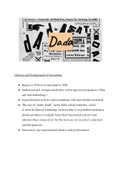Dada
History and background of movement
● Began in 1916 in switzerland to 1925
● Embraced and critique modernity (referring too newspapers, films,
ads and technology )
● Experimented with art and artmaking with unorthodox materials
● The use of “ready made” items (bike wheel, fountain, stool)
A term by Marcel Duchamp, he describes it as prefabricated/mass
produced objects isolated from their functional context and
elevates their status of art by the mere act of an artist's selection
and designation.
● Innovative, eg; experimental theatre and performance
,What does Dada mean?
● Anti art
● A nonsense word
● Avant garde ( innovative, experimental, inventive techniques or
ideology
The First International Dada Fair took place in Berlin in 1920. It was Grosz, Heartfield and Hausmann.
It was to become the most famous of all Berlin Dada's exploits
Why did it come about ?
● Dada was born out of a negative reaction to the horrors of the First
World War. Dada rejected reason and logic, prizing nonsense,
irrationality and intuition.
Aims of Dada?
● Dada artists felt the war called into question every aspect of a
society capable of starting and then prolonging it – including its
art.
● Their aim was to destroy traditional values in art and to create a
new art to replace the old
,Two artists
Marcel Duchamp
● was a French painter, sculptor, chess player, and writer whose work
is associated with Cubism, Dada, and conceptual art
● Introducing the concept of “Readymades,” as he called them,
disrupted centuries of thinking about the artist's role as a skilled
creator of original handmade objects. Instead, Duchamp argued,
“An ordinary object could be elevated to the dignity of a work of
art by the mere choice of an artist.”
● Born: 28 July 1887, Blainville-Crevon, France
● Died: 2 October 1968, Neuilly-sur-Seine, France
Kurt Schwitters
● was a German artist who was born in Hanover, Germany.
Schwitters worked in several genres and media, including dadaism,
constructivism, surrealism, poetry, sound, painting, sculpture,
graphic design, typography, and what came to be known as
installation art.
, Two art works
Marcel Duchamp’s
Fountain
1917
Porcelain urinal
● Standard urinal laid flat on its back
Rather than in its usual position
● Signed by his pseudonym
(a fictional name) “R Mutt 1917”
● An example of his readymade artworks
● He did this to shi viewers engagement with a work of art, from
what he called “retinal” meaning to please the eye to “intellectual”
meaning in service of the mind
● By doing this he changed the traditional notion that beauty is a
defining characteristic of art
● This artwork tests the limits of what is a work of art, by
designating ordinary objects as works of art by signing it and
placing it on a pedestal
,Kurt Schwitters’
The Cherry Picture
1921
Merz Picture 32 A
● Merz is a nonsense word
invented by the German dada
artist Kurt Schwitters to
describe his collage and
assemblage works based on scavenged scrap materials.
● He came up with the term Merz in the process of creating a
collage with the German word Kommerz, which translates to
“commerce” meaning to create connections
● Made from scraps and objects collected from the streets,
glued and nailed objects to a painted board to make this
collage
● This abstract image never lets your eye rest and is
constructed of various shapes. The only truly recognizable
image is one of a cherry directly in the middle of the image.
● Schwitters uses light and dark material, along with pencil
and ink to create an illusion of overlapping objects. It kills
the idea that the piece is a two-dimensional object and
creates layers.
● You also see a few glimpses of text. This is just an example
of how he used everyday items off the streets to construct his
work, further connecting reality to an abstract view of art
and beauty.
, ● This image is a great example of Dada style art. The
connection between real life and abstract is its defining
quality.
● He said a er WW1 “Everything had broken down in any case
and new things had to be made out of the fragments”




